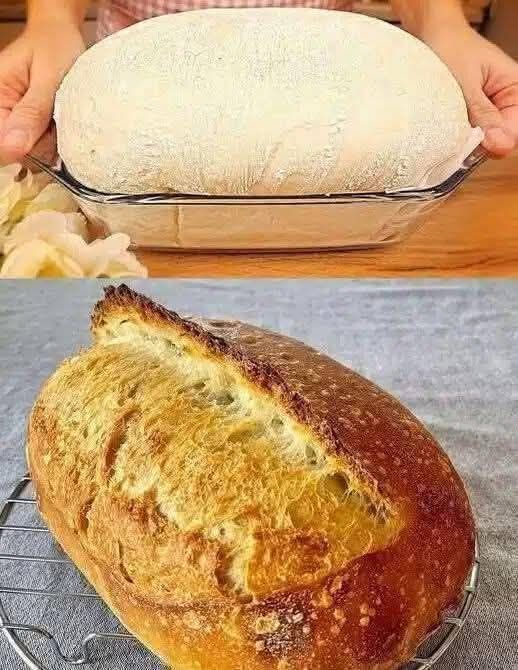Classic Homemade Bread – Soft, Simple, and Irresistibly Delicious
Nothing beats the aroma of freshly baked homemade bread filling your kitchen. With its golden crust, soft interior, and rich flavor, this classic homemade bread recipe is a timeless staple that brings warmth and comfort to any meal. Whether you’re an experienced baker or just beginning your bread-making journey, this foolproof recipe will guide you through creating loaves that are perfectly fluffy, flavorful, and satisfying.
🍞 Why You’ll Love This Bread Recipe
- No special equipment required
- Minimal ingredients
- Soft, fluffy texture with a light crust
- Perfect for sandwiches, toast, or served warm with butter
- Beginner-friendly and budget-conscious
🧂 Ingredients for Classic Homemade Bread
| Ingredient | Quantity |
|---|---|
| Dry yeast | 10 grams (1 packet) |
| Warm water | 200 ml (for yeast) + 400 ml later |
| All-purpose flour | 720 grams (6 cups) + 120 grams (1 cup) |
| Salt | 10 grams (1 teaspoon) |
| Egg yolk | 1 (for brushing) |
| Milk | 1 tablespoon (for brushing) |
💡 Note: Use high-quality flour for best results. Bread flour can be substituted for a chewier crumb.
🍽️ Step-by-Step Instructions
🔸 1. Activate the Yeast
In a mixing bowl, dissolve 10g of dry yeast in 200 ml of warm water (around 100°F/38°C). Stir gently until completely dissolved.
⚠️ Tip: Ensure the water is warm, not hot—too hot will kill the yeast.
🔸 2. Make the Sponge Starter
Add 120g (1 cup) of flour into the yeast mixture and stir until smooth. This forms the sponge base for your bread.
- Cover the bowl with a towel or plastic wrap.
- Let rest for 15 minutes to begin fermentation.
🔸 3. Mix and Knead the Dough
After resting:
- Add 400 ml warm water, mix well.
- Gradually incorporate the remaining 720 grams (6 cups) of flour and 1 tsp salt.
- Knead for 3–4 minutes until you form a soft, slightly tacky dough.
👐 If the dough is too sticky, dust with small amounts of flour. If too dry, wet your hands while kneading.
🔸 4. First Rise (Fermentation)
- Place the dough in a lightly oiled bowl, cover, and let rise in a warm spot until doubled in size—about 1 to 1.5 hours.
🔸 5. Punch Down and Shape
- Gently punch the dough to release air.
- Divide into 2 equal parts and shape each into a ball.
- Let them rest for 10 minutes, covered with a damp cloth.
🔸 6. Final Shaping
On a lightly floured surface:
- Flatten each ball with your fingers into a rectangle.
- Roll the dough inward (like a jelly roll) to form loaves.
- Pinch the seams and place them seam-side down on a lined baking tray.
🔸 7. Final Proof (Second Rise)
- Cover the loaves loosely with a towel.
- Let them rest for 20 minutes until slightly puffy.
🔸 8. Glaze and Bake
- Preheat oven to 200°C (392°F).
- Mix 1 egg yolk with 1 tablespoon milk and brush the loaves for a shiny golden crust.
- Bake for 25–30 minutes or until golden brown and hollow-sounding when tapped.
🍯 Optional: Brush with butter after baking for a soft crust.
🧈 Serving Suggestions
- Serve warm with butter, honey, or your favorite jam.
- Slice for sandwiches or French toast.
- Perfect side with soups, stews, or salads.
- Make garlic bread or toast with olive oil and herbs.
🧠 Expert Tips for Perfect Bread
✅ Use room-temperature ingredients to promote even fermentation.
✅ Don’t over-knead — a few minutes is enough to develop gluten.
✅ Let the dough rise in a draft-free, warm place.
✅ For a crispier crust, place a small dish of water in the oven to create steam.
✅ Want extra flavor? Add rosemary, garlic, cheese, or seeds to the dough.
🍞 Nutritional Information (Per Serving)
| Nutrient | Amount |
|---|---|
| Calories | 150 kcal |
| Total Fat | 1.5g |
| Saturated Fat | 0.5g |
| Cholesterol | 20mg |
| Sodium | 300mg |
| Total Carbohydrates | 30g |
| Dietary Fiber | 1g |
| Sugars | 1g |
| Protein | 4g |
🔍 Suitable for vegetarians
⚠️ Contains gluten (from flour) and egg (in the glaze)
🧊 Storage & Make-Ahead Tips
- Room Temperature: Store in a breadbox or airtight bag for up to 3 days.
- Freezer: Wrap tightly in plastic or foil and freeze for up to 3 months.
- Thaw at room temperature or warm in the oven at 300°F (150°C) for 10 minutes.
- To Reheat: Toast slices or warm whole loaves in the oven for fresh-baked texture.
❓ Frequently Asked Questions
Can I use whole wheat flour?
Yes, but replace only up to half of the all-purpose flour with whole wheat for best texture.
Why did my bread not rise?
The yeast may have been old, or the water was too hot/cold. Always check expiration dates and water temperature.
Can I knead the dough by hand?
Absolutely. It just takes a little more time (around 8–10 minutes of firm kneading).
How do I know when the bread is done?
Tap the bottom of the loaf—it should sound hollow. Internal temperature should be around 190°F (88°C).
🍽️ Final Thoughts
Classic Homemade Bread is one of life’s simplest pleasures. With its soft crumb, crusty golden exterior, and rich, comforting flavor, this easy recipe is a must-have in every home cook’s collection. Once you make your own bread from scratch, you’ll never go back to store-bought again.
Enjoy the process, share it with loved ones, and savor every slice of your freshly baked masterpiece.
